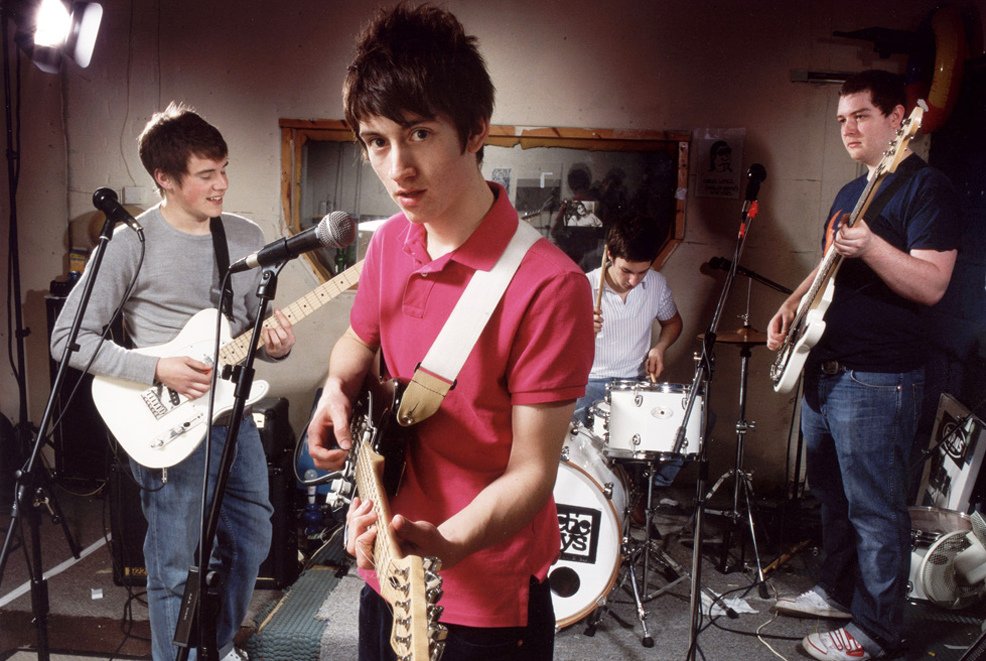Formed in the steel city of Sheffield, England, in 2002, the Arctic Monkeys burst onto the rock scene with a sound that was both unmistakably British and undeniably universal. Comprising Alex Turner, Jamie Cook, Nick O’Malley, and Matt Helders, the band melded punk energy with indie rock finesse, infused with lyrical narratives that captured the mundane and the surreal of British nightlife. In an era dominated by heavily marketed pop acts and manufactured stars, the Arctic Monkeys’ ascent represented a stark deviation from the norm. Their early music, characterized by sharp, witty lyrics and vibrant, energetic rhythms, quickly captured the hearts of a disenchanted youth, eager for authenticity and relatability.
The Arctic Monkeys’ rise was not just notable for their music but also for their pioneering approach to promotion. In the mid-2000s, as the internet began to reshape countless aspects of daily life, it also started to transform the music industry, a change that was not yet fully understood by many established players. The Arctic Monkeys, often heralded as the first internet band, leveraged this emerging platform with an adeptness that was ahead of their time.
By uploading their demos to MySpace, they created a digital footprint that circumvented traditional music promotion avenues. This strategy not only facilitated an organic growth of their fan base but also marked a significant shift in how music could be promoted. They empowered fans to share, discuss, and promote their music in ways that had not been possible before, setting a template that would become the norm in the ensuing digital age.
The Early Days of Arctic Monkeys

The Arctic Monkeys formed in 2002 when school friends Alex Turner, Jamie Cook, Nick O’Malley, and Matt Helders, hailing from the High Green suburb of Sheffield, England, decided to start a band. None of them were proficient with their instruments at the outset, but what they lacked in technical skill, they compensated for with raw passion and a keen ear for the music scene burgeoning around them. Their sound—a gritty blend of punk rock and garage band revival with an indie twist—resonated with the post-punk revival then sweeping through the UK. Turner’s sharp, observational lyrics and distinctive vocal style quickly became signature elements of their music, capturing the complexities and frustrations of urban youth culture.
A DIY Approach
From the beginning, the Arctic Monkeys adopted a DIY approach to music distribution, a strategy that starkly contrasted with the era’s prevailing music industry practices. They began by burning demo CDs to hand out at gigs, which not only circulated through Sheffield’s live music scene but also quickly spread beyond the city. These demos included early versions of tracks that would later become fan favorites, like “I Bet You Look Good on the Dancefloor” and “Fake Tales of San Francisco.” This grassroots distribution method was crucial in building a local following, as fans felt a personal connection to the band, sharing their music through word-of-mouth and thus amplifying their reach organically.
In addition to their physical distribution efforts, the band—or more accurately, their early fans—also capitalized on the burgeoning capabilities of the internet. Fans took the initiative to upload these demos to online platforms like MySpace, further broadening the band’s audience. This unintentional yet effective online strategy complemented their energetic live performances, creating a buzz that quickly transcended their local scene. The Arctic Monkeys’ initial approach to music distribution was not only innovative due to its embrace of the internet but also reflected a deeper shift in the music industry, where control was starting to move from industry gatekeepers to the artists and their fans.
The Role of the Internet in Their Rise

Utilization of MySpace
As the Arctic Monkeys began carving out their space within the music landscape of Sheffield, the wider world was experiencing a digital revolution—MySpace was becoming a household name, offering musicians a platform like no other before. While the Arctic Monkeys themselves were initially less active in cultivating their online presence, their fans were not. These early adopters took the reins, uploading the band’s demos to MySpace, effectively setting the stage for one of the most notable grassroots promotional campaigns in modern music history.
This serendipitous use of MySpace by their fans enabled the Arctic Monkeys to reach a far broader audience than local gigs alone could have provided. The platform allowed the band to create a profile where users could play their music on demand, leave comments, and share tracks with ease—features that were revolutionary at the time. As a result, Arctic Monkeys’ MySpace page became a buzzing hub of activity, garnering an increasing number of plays and followers each day. The digital word-of-mouth facilitated by MySpace was crucial; it created a sense of community and belonging among listeners, and significantly, it did so on a global scale.
Impact of Online Sharing and Fan Involvement
The Arctic Monkeys’ rise was significantly amplified by their fans’ active involvement in sharing their music. This early example of viral marketing saw fans not only spreading the word through MySpace but also through various other online forums and peer-to-peer download sites. The phenomenon was organic, a digital wildfire that was unpredictable and overwhelmingly positive. This level of engagement created a feedback loop: as more people heard about the band, more sought them out on MySpace, further elevating their profile.
The impact of this fan-driven promotion cannot be overstated. It bypassed traditional music industry pathways, which typically involved curated press releases, radio play, and managed publicity. Instead, Arctic Monkeys’ music spread because it resonated with the listeners, and those listeners took it upon themselves to share their enthusiasm. This not only helped build a substantial fan base but also instilled a deep-rooted loyalty among the fans, who felt directly involved in the success of their new favorite band.
Moreover, the band’s viral internet success translated into tangible real-world outcomes. By the time the Arctic Monkeys released their debut album, “Whatever People Say I Am, That’s What I’m Not,” there was already a palpable buzz awaiting its release. The album became the fastest-selling debut album in British music history at the time, a testament to the unprecedented hype generated by their innovative use of the internet and the vital role their fans played in their ascent. The Arctic Monkeys’ story is a compelling illustration of how the internet began to democratize music discovery and promotion, changing the industry forever.
Breaking Records and Setting Trends

Mainstream Breakthrough
The Arctic Monkeys’ transition from internet sensation to mainstream powerhouse culminated with the release of their debut album, “Whatever People Say I Am, That’s What I’m Not,” in January 2006. The album’s success was unprecedented and largely fueled by the fervent online buzz they had generated. Upon its release, the album sold over 360,000 copies in its first week in the UK alone, setting a record for the fastest-selling debut album in British music history at the time. This remarkable achievement was not solely a result of traditional marketing or media exposure but was significantly propelled by the band’s digital presence and the grassroots campaign that their fans had initiated.
This direct translation of online popularity into commercial success demonstrated a powerful new dynamic in the music industry. It showed that internet buzz could not only complement but in some cases replace traditional avenues of promotion and distribution. The band’s strategy leveraged their online traction to boost physical album sales, highlighting a synergistic relationship between digital presence and traditional sales that many were skeptical about before.
Influence on the Music Industry
The Arctic Monkeys’ success story marked a pivotal moment in the music industry, influencing how music was promoted in the digital age. Their ability to harness the power of the internet, particularly social media platforms like MySpace, served as a blueprint for other artists and record labels. The industry, which had been grappling with the impacts of online piracy and the decline of physical sales, began to see the internet as a vital tool for building artist profiles and engaging with a broader audience.
This shift led to an increased focus on digital marketing strategies, social media engagement, and online music streaming services. Bands and solo artists started to recognize the importance of having a strong online presence, not just for promotion but also for creating a sense of community and loyalty among fans. Record labels and music marketers adapted by allocating more resources to digital campaigns, social media management, and data analytics to track online engagement and predict trends.
Furthermore, the Arctic Monkeys’ model encouraged the music industry to embrace more democratic promotion tactics, where the focus shifted towards genuine artist-fan interactions. The success of this approach prompted a reevaluation of how artists were discovered, signed, and promoted. No longer were gatekeepers the sole arbiters of musical success; the digital realm had democratized access to music and flattened the playing field, enabling more artists to break through based on merit and public appeal rather than solely through industry connections.
Analysis of Marketing Strategies

Digital Marketing Tactics
The Arctic Monkeys leveraged several key digital marketing tactics that were revolutionary at the time and have since become standard practice in the music industry. Their use of the internet, particularly social media, was instrumental in their rise. Unlike many bands of their era who relied on their labels to manage online profiles, the Arctic Monkeys benefited from organic growth driven by their fans. This grassroots strategy was not orchestrated but emerged from the bottom up, as enthusiastic listeners shared their music across platforms like MySpace.
Social Media Interactions: The band’s MySpace page became a hub for fans to listen to their music, learn about upcoming gigs, and interact with other fans. The Arctic Monkeys’ page was regularly updated with new songs, tour dates, and news, keeping fans engaged and informed. Importantly, the band’s members occasionally interacted with fans through MySpace, adding a personal touch that many commercial bands lacked at the time. This direct artist-to-fan communication fostered a loyal community around their music.
Digital Releases: Prior to the official release of their albums, the Arctic Monkeys made several tracks available for listening online. This approach not only built anticipation among the fanbase but also allowed the band to gauge which songs were receiving the most positive feedback, influencing decisions about singles and album track listings.
Comparison with Traditional Music Promotion
Traditional music promotion strategies at the time relied heavily on a mix of radio plays, music videos on television, press releases, and magazine interviews. Record labels typically controlled the narrative and often invested heavily in advertising campaigns to build hype around new releases.
Controlled Exposure vs. Organic Growth: Unlike the Arctic Monkeys’ approach, traditional strategies often involved tightly controlled exposure of music to the public. Record labels aimed to create demand by limiting access to new music until official releases. In contrast, the Arctic Monkeys’ music was widely accessible online before their album officially dropped, which helped them build a substantial and engaged audience.
Gatekeepers vs. Direct Access: Traditional methods were dominated by industry gatekeepers such as radio DJs and music television networks, who decided what music would reach the audience. The Arctic Monkeys circumvented these gatekeepers, directly reaching listeners through MySpace and other online platforms. This democratization of music distribution removed barriers between the band and their fans, allowing for more natural and rapid dissemination of their music.
Cost-Effectiveness: Traditional promotion was often expensive, involving elaborate marketing campaigns and distribution methods. The Arctic Monkeys’ digital-first approach was far more cost-effective, relying on digital platforms that required minimal financial outlay but could reach a global audience almost instantly.
Legacy and Continuing Influence

Long-term Effects on the Music Industry
The Arctic Monkeys’ innovative use of digital media to promote their music and engage with fans has left a lasting imprint on the music industry. Their early adoption of internet platforms for music distribution fundamentally shifted the industry’s approach to marketing, fan engagement, and the development of new artists.
Influence on Other Bands: Following the success of the Arctic Monkeys, numerous bands and solo artists began to emulate their approach, recognizing the potential of social media as a powerful tool for building and maintaining fan bases. This marked a shift towards more interactive and direct relationships between artists and fans, with platforms such as Twitter, Facebook, and later Instagram and TikTok becoming essential in the promotional mix of almost every music artist.
Change in Industry Practices: The music industry, once skeptical about the disruptive potential of the internet, started to integrate digital strategies as a core component of marketing plans. Record labels began investing in digital marketing teams and social media strategists to harness the same viral potential that propelled the Arctic Monkeys to stardom. Furthermore, the success of such digital campaigns underscored the value of data-driven marketing, with analytics tools becoming crucial for understanding fan behaviors and preferences.
Evolution of Their Promotional Tactics
Over the years, the Arctic Monkeys have continued to innovate and adapt their promotional tactics to align with evolving digital media landscapes and changing consumer behaviors.
Continued Digital Engagement: As social media platforms evolved, so did the band’s strategies for engaging with their audience. For their later albums, such as “AM” and “Tranquility Base Hotel & Casino,” the Arctic Monkeys utilized a more polished, multi-platform approach that included teasers, singles released via streaming services, and interactive online content to engage fans and stimulate discussion.
Creative Content Delivery: The band has also embraced more sophisticated forms of digital content, such as producing high-quality music videos and documentary-style behind-the-scenes footage, which are distributed primarily online. These efforts not only serve to maintain interest among existing fans but also to attract new listeners in an increasingly crowded digital marketplace.
Adaptation to Streaming: Recognizing the shift from digital downloads to streaming, the Arctic Monkeys have strategically released their music on all major streaming platforms, often with exclusive content or early releases for specific services. This approach ensures they remain relevant and accessible in the digital age, where streaming has become the primary mode of music consumption.
In conclusion, the Arctic Monkeys not only pioneered the use of digital media for music promotion but have also continued to adapt and thrive in the ever-changing landscape of the music industry. Their legacy is evident in the widespread adoption of digital marketing techniques across the industry and in the ongoing evolution of how music is shared, consumed, and enjoyed worldwide. Their continued success and innovation serve as a blueprint for both emerging artists and established acts looking to engage with the digital generation.
